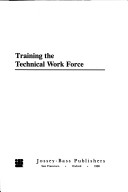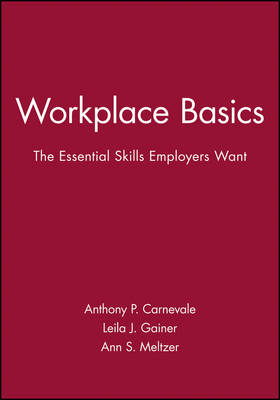The ASTD best practices
3 total works
Training the Technical Workforce
by Anthony P. Carnevale, etc., Leila J. Gainer, and Eric R. Schulz
Published 13 April 1990
This fourth volume in the ASTD Best Practices Series represents the findings of a three-year ASTD/US Department of Labour study addressing the training needs of America's enormous technical work force. This population includes such technical professionals as scientists, doctors and engineers, technicians such as hygienists and draftsmen and skilled trade or blue-collar workers. In this new book, the authors desribe the nature and role of technical training within today's competitive and technologically shifting workplace and set forth specific guidelines for conducting effective technical training programmes inside employer institutions. The authors survey how successful technical training programmes are structured, organized and implemented within the workplace and provide case studies from ten Fortune 500 companies, illustrating the best approach for training in each organization. Each case study focuses on the organization's strategic goals and training structure, and explains how training supports the strategic goals.
This series of books represents the full findings of a landmark study conducted by the American Society for Training and Development, funded by a major grant from the US Department of Labour. The study was commissioned to identify the best practices in training and development throughout the United States and to gain a greater understanding of the enormous training enterprise - its scope, capabilities, practices and effectiveness in meeting the needs of the changing work force. These publications focus on three main areas, addressing both policy and practice issues - organization and strategic role of training, basic workplace skills training, and technical training. In each of these areas, the authors and their ASTD staff surveyed hundreds of experts from the fields of economics, adult education, management, training, public policy, and strategic planning along with leaders from industry and government. They formed extensive networks and advisory panels throughout the business and education communities, private industry councils, and other professional associations, and tapped both private and public employers for examples of successful training systems and practices.
Preliminary reports of the study have received widespread attention and many of its initial findings have been cited in the national press and professional journals. This series is intended to shift this dialogue to action by providing practical resources for improving training practices and systems for the changing workplace.
This series of books represents the full findings of a landmark study conducted by the American Society for Training and Development, funded by a major grant from the US Department of Labour. The study was commissioned to identify the best practices in training and development throughout the United States and to gain a greater understanding of the enormous training enterprise - its scope, capabilities, practices and effectiveness in meeting the needs of the changing work force. These publications focus on three main areas, addressing both policy and practice issues - organization and strategic role of training, basic workplace skills training, and technical training. In each of these areas, the authors and their ASTD staff surveyed hundreds of experts from the fields of economics, adult education, management, training, public policy, and strategic planning along with leaders from industry and government. They formed extensive networks and advisory panels throughout the business and education communities, private industry councils, and other professional associations, and tapped both private and public employers for examples of successful training systems and practices.
Preliminary reports of the study have received widespread attention and many of its initial findings have been cited in the national press and professional journals. This series is intended to shift this dialogue to action by providing practical resources for improving training practices and systems for the changing workplace.
Workplace Basics, Training Manual
by Anthony P. Carnevale, Leila J. Gainer, and Ann S. Meltzer
Published 29 March 1990
Presents the findings of a three-year ASTD/U.S. Department of Labor nationwide study on how to develop a skilled workforce capable of meeting today's business requirements. Explains how to implement training programs that develop the new basic skills workers will need.
Training in America
by Anthony P. Carnevale, etc., Leila J. Gainer, and Janice Villet
Published 9 March 1990
The overall findings of a three-year ASTD/US Department of Labour nationwide study on how training for today's workplace is structured, managed, financed and linked to organizational strategy. It catalogues who gets training and how much and it shows what employer-based training systems look like. It also spells out how to select and contract with outside training-providers and consultants and how to build lasting partnerships with these groups. The authors demonstrate the importance of linking training to organizational strategy, and detail specific techniques for building training programs that are responsive to an organization's most critical needs. They explain how to gain access to decision-makers and specifically what questions to ask and what approach to take in gaining a commitment for training. They describe the role of training in different business settings, providing examples from organizations that are experiencing internal and external growth or reductions. And they present policy recommendations for educators, employers, and government officials that will ensure the commitment of resources and support that effective training requires.


